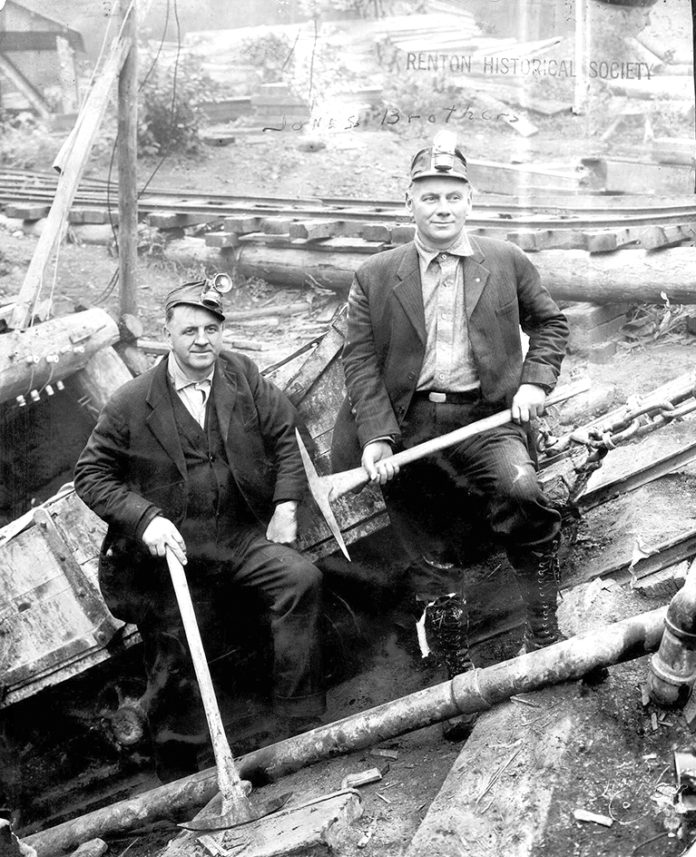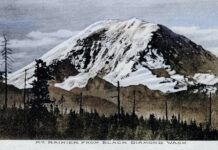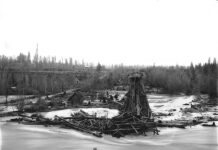In the mid-1920s, Pacific Coast Coal Company was facing an existential crisis. Its highly successful Mine #11 in Black Diamond was increasingly fraught with dangers. Opened in 1896, the mine reached a depth of over 2,000 feet causing excessive pressures underground. Bumps and bounces, in effect mini-earthquakes were felt on the surface and resulted in several instances where miners were killed. In addition, oil from the California fields was replacing coal as the fuel of choice for many industries including railroad locomotives. Washington State production declined from a 4-million-ton peak in 1918 to almost half of that by 1930.
Rather than continuing to operate Black Diamond’s Mine #11 that had produced 7 million tons, the company purchased a small mine operated by the Jones Brothers near Lake Desire. Pacific Coast also acquired 600 nearby acres in 1924 from Cedar Mountain Coal Company to consolidate their new facilities. This photo of Tom Jones, left, and Ed Jones, right, was taken in Oct. 1925 at the Jones slope where the two brothers began operations in 1919. They started the mine after obtaining a lease from Fred and Edith Cavanaugh, who in 1906 opened tunnels to access new seams of coal. The Jones Brothers called their operation the “Indian Mine,” named for the coal seam they were selling.
Pacific Coast spared no expense in gearing up production, spending a million dollars to drive a tunnel connecting the slope in this photo to the site of their new processing plant, shop, offices, and rail facilities along the Renton-Maple Valley Highway, now known as S.R. 169. The “million-dollar tunnel” was constructed to great fanfare and featured in national publications for the engineering miracle of joining two tunnels coming from opposite directions hundreds of feet underground. The tunnel was over a mile long and followed a circuitous route under the heart of Cedar Mountain.
The operation was named the New Black Diamond mine, but many locals referred to it as the “Indian.” It operated from 1926 to 1941, producing 2.4 million tons of clean coal. At the height of operations, Pacific Coast employed nearly 300 miners, many of whom lived in company homes back in Black Diamond. The mine operated three shifts a day with many workers riding trains that provided service between the mine and Black Diamond. After it closed, the mine’s office and shop buildings were sold to King County Roads, then later operated by Sunset Materials. The property is currently owned by Lakeside Industries and is the prospective site of an asphalt plant.
Tom and Ed Jones were of Welsh stock, like many of the early coal miners in Washington. Their parents, Benjamin Jones and Ann Jones emigrated from Wales via Victoria B.C. in 1869 landing in King County a year later. By 1878, the family homesteaded on the Cedar River, near where James Colman would open the area’s first coal mine in 1884, after the Columbia & Puget Railroad began laying tracks to Black Diamond and Franklin. Ed Jones was the second Mayor of Renton, serving from 1904-1908. Both the Jones Road and Jones Bridge over the Cedar River at 196th Ave S.E. are named for the Jones family.
This photo #1966.044.0172 comes courtesy of the Renton History Museum. Photo enhancements to improve the image quality were undertaken by Doug “Boomer” Burnham, a Tahoma High School teacher whose photography business can be found at www.BoomersPhotography.com . Additional information was provided by Liz Stewart of the Museum and Robin Adams whose Crows of Arroyos blog can be found at http://batgurrl.wordpress.com/. Next week, more about the New Black Diamond mine.







